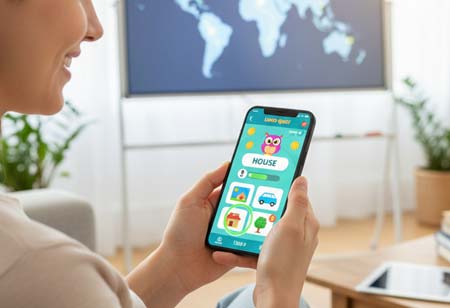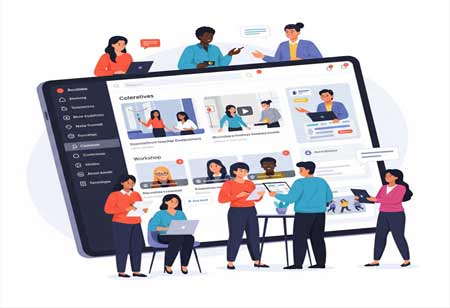THANK YOU FOR SUBSCRIBING
Be first to read the latest tech news, Industry Leader's Insights, and CIO interviews of medium and large enterprises exclusively from Education Technology Insights
Exploring How Technology Enhances Student Engagement in Higher Education
In today's digital age, technology has become an integral part of everyday lives, transforming various aspects of society, including education.

By
Education Technology Insights | Wednesday, May 17, 2023
Stay ahead of the industry with exclusive feature stories on the top companies, expert insights and the latest news delivered straight to your inbox. Subscribe today.
Technology is improving higher education with personalised and immersive learning, machine learning, AI, and location-based services, enhancing student engagement, safety, and success.
FREMONT, CA: In today's digital age, technology has become an integral part of everyday lives, transforming various aspects of society, including education. Traditional teaching methods are being supplemented and transformed by innovative technological tools and platforms, leading to enhanced student engagement. From interactive learning experiences to personalised instruction, technology has the potential to create a more dynamic and inclusive educational environment. In the realm of higher education, technology is playing a crucial role in enhancing student engagement. Traditional methods of teaching and learning are gradually being replaced by innovative technological solutions that foster interactive and immersive learning experiences.
Digital technologies assist in reducing stress among students. A smart campus that leverages the Internet of Things and other technologies helps improve the learning experience and engages the next generation of administrators creating an ideal environment for learning. As higher education institutions strive to meet the evolving needs of students, the concept of student engagement has become increasingly important.
Access to a Wealth of Information: Technology has made vast amounts of information readily accessible to students. With just a few clicks, students can access a multitude of online resources, academic databases, e-books, research articles, and multimedia content. This access empowers students to explore diverse perspectives, deepen their understanding of subjects, and engage with a wider range of learning materials.
Collaborative Learning Opportunities:Technological advancements have provided numerous opportunities for collaborative learning. Online platforms, discussion forums, and virtual classrooms enable students to connect with their peers, share ideas, engage in group projects, and engage in meaningful discussions. Collaborative learning fosters a sense of community and encourages active participation, enhancing student engagement and promoting a deeper understanding of the subject matter.
Interactive Multimedia Tools: Technology offers a wide array of interactive multimedia tools that engage students in the learning process. Videos, simulations, virtual reality (VR), augmented reality (AR), and gamification provide immersive and interactive learning experiences. These tools cater to various learning styles, making the educational content more engaging, memorable, and accessible.
Personalised Learning Experiences: Technology allows for personalised learning experiences tailored to individual student needs and preferences. Learning management systems (LMS), adaptive learning platforms, and intelligent tutoring systems analyze student data and provide personalized recommendations, adaptive assessments, and customized learning paths. This individualized approach to education boosts student engagement by addressing their specific strengths, weaknesses, and learning pace.
Real-Time Feedback and Assessment:Technology facilitates real-time feedback and assessment, enabling students to gauge their progress instantly. Online quizzes, automated grading systems, and interactive assessments provide immediate feedback, helping students identify areas that require improvement. This timely feedback motivates students, reinforces their learning, and encourages them to actively participate in the learning process.
Enhanced Communication and Accessibility: Technological tools enhance communication between students and educators. Emails, instant messaging, video conferencing, and online discussion platforms enable seamless communication, allowing students to seek clarification, discuss ideas, and engage in virtual office hours. Moreover, technology promotes accessibility by providing accommodations for students with disabilities, ensuring an inclusive learning environment.
Higher education leaders globally recognise the significance of enhancing campus life by implementing smart technologies and upgrading facilities to stay current with technological advancements. With a large number of tech-savvy students, universities are prioritising their need to prepare them for the future. To enhance student engagement, these technologies will be utilised in higher education:
Blended Learning Environments: Blended learning, combining face-to-face instruction with online elements, is gaining momentum in higher education. This approach leverages technology to provide students with flexible learning opportunities, allowing them to engage with course materials at their own pace. Blended learning environments encourage active learning through a combination of in-person discussions, collaborative projects, and online resources. This hybrid model promotes deeper engagement and enables students to take ownership of their learning.
Virtual and Augmented Reality: Virtual and augmented reality (VR/AR) technologies have the potential to revolutionise student engagement in higher education. By creating immersive experiences, these technologies can transport students to virtual environments that simulate real-world scenarios. For instance, medical students can practice surgical procedures in a virtual operating room, or history students can visit ancient civilisations through augmented reality. VR/AR enhances student engagement by making learning more interactive, memorable, and applicable to real-life situations.
Gamification and Experiential Learning: Gamification techniques, such as leaderboards, badges, and rewards, can be employed to increase student engagement in higher education. By incorporating game elements into the learning process, educators can tap into students' natural inclination for competition and achievement. Experiential learning, which involves hands-on activities and real-world applications, also enhances engagement. Field trips, internships, and project-based assignments provide students with practical experiences that connect theory to practice and foster deeper understanding.
The future of student engagement in higher education is dynamic, technology-driven, and focused on personalization and collaboration. Blended learning environments, virtual and augmented reality, gamification, personalized learning, and global connections are reshaping the educational landscape
Technology has significantly transformed student engagement in higher education. By providing easy access to information, fostering collaborative learning, offering interactive multimedia tools, enabling personalized learning experiences, facilitating real-time feedback and assessment, and enhancing communication and accessibility, technology has revolutionised the educational landscape. Embracing technology in higher education is crucial to creating an engaging, interactive, and inclusive learning environment that prepares students for the challenges of the modern world. As technology continues to evolve, its impact on student engagement will undoubtedly shape the future of higher education.







